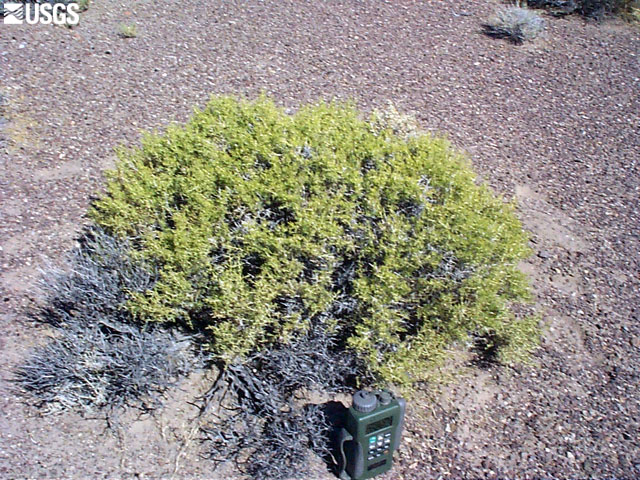- Greasewood
Taxobox
name = Greasewood

regnum =Plant ae
divisio = Magnoliophyta
ordo =Caryophyllales
familia =Sarcobataceae
genus = "Sarcobatus"
genus_authority = Nees (1839)
subdivision_ranks = species
subdivision = see textGreasewood ("Sarcobatus") is a genus of one or two
species offlowering plant s. Traditionally it has been treated in the familyChenopodiaceae , but theAPG II system , of 2003, places it in the familySarcobataceae ., 10–40 mm long and 1–2 mm broad. The leaves are green, in contrast to the grey-green color of most of the other shrubs within its range. The flowers are unisexual and appear from June to August. The species reproduces from seeds and sprouts. The green or tan fruit is small and winged. Small brown seeds are contained inside the fruit. [http://extension.usu.edu/range/Woody/greasewood.htm Utah State University] .]
Their area of distribution is western
North America , from southeasternBritish Columbia and southwestAlberta ,Canada , south through the drier regions of theUnited States (east toNorth Dakota and westTexas , west to centralWashington and easternCalifornia ) to northernMexico (Coahuila ).Greasewood is a
halophyte , and is commonly found in sunny, flat areas around the margins ofplaya s and in dry stream beds and arroyos. It is replaced byIodine bush in extremely saline environments, such as hummocks within the playa itself. Greasewood often grows in extensive, nearly pure stands in pluvial desert locations. Greasewood does not grow exclusively in highly saline areas, but is most common on fine-grained soils in areas with a relatively high water table.Although it can be grazed by animals that are adapted, grazing of greasewood by sheep and cattle can result in
oxalate poisoning resulting in kidney failure [http://www.ivis.org/special_books/Knight/chap7/chapter_frm.asp?LA=1#Greasewood] . The active agent can be eithersodium oxalate orpotassium oxalate . Sheep are the most vulnerable. Greasewood was commonly used for firewood by Native Americans and early settlers.Species
The two species are not accepted as distinct by all authors; see the "Flora of North America" for further details.
*"Sarcobatus baileyi" Coville (syn. "Sarcobatus vermiculatus" var. "baileyi" (Coville) Jepson).Nevada , endemic. Low shrub 0.5–1 m tall. Leaves hairy, 10–16 mm long.
*"Sarcobatus vermiculatus" (Hook.) Torr.. Throughout the range of the genus. Shrub 1–5 m tall. Leaves hairless or only slightly hairy, 15–40 mm long.The name "Sarcobatus" comes from Greek "sarko" (meaning "flesh") and "batos" (meaning "bramble"), referring to the species' spiny branches and
succulent leaves.External links
* [http://www.efloras.org/florataxon.aspx?flora_id=1&taxon_id=129190 Flora of North America: "Sarcobatus"]
* [http://ucjeps.berkeley.edu/cgi-bin/get_JM_treatment.pl?Sarcobatus+vermiculatus Jepson Flora: "Sarcobatus vermiculatus"]
* [http://www.explorenm.com/plants/Chenopodiaceae/Sarcobatus/vermiculatus/ Extensive description with images explorenm.com, Explore New Mexico]
* [http://plants.usda.gov/java/profile?symbol=SAVE4 USDA National Database]
* [http://www.usask.ca/agriculture/plantsci/classes/range/sarcobatus.html University of Saskatchewan info]
* [http://extension.usu.edu/rangeplants/Woody/greasewood.htm Utah State University info]
* [http://www.malag.aes.oregonstate.edu/wildflowers/species.php/id-817 Oregon State University info]
* [http://www.umt.edu/mnps/Sarcobatus_vermiculatus.pdf University of Montana info pdf file] [http://66.102.7.104/search?q=cache:X2upiSO05eEJ:www.umt.edu/mnps/Sarcobatus_vermiculatus.pdf+greasewood+%22Sarcobatus+vermiculatus%22&hl=en html file]References
Wikimedia Foundation. 2010.
